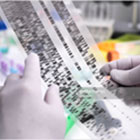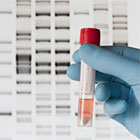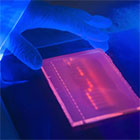Gene Editing Technology, Tools, and Resources
Gene Editing is the application area concerned with the intentional alteration of the DNA sequence of a plasmid, cell or organism. Gene editing encompasses numerous methods including mutagenesis, restriction cloning, synthetic biology and CRISPR/Cas9, among others.
Featured Suppliers for Gene Editing

Quantabio - advanced DNA and RNA Amplification Reagents
Quantabio amplification reagents for the most demanding molecular testing applications in applied, translational and life science research.

Life Science Solutions from Analytik Jena
Analytik Jena is a leading provider of life science products, including BioImaging, PCR, and Real-Time PCR systems for academic, pharmaceutical and biotechnology applications.
Construction
Obtain proven DNA construction products to effectively assemble genes or fragments of DNA sequences together.

Transformation & Amplification
Our wide range of high-quality products includes everything your lab needs for successful transformation and amplification processes.

Products
Extraction & Purification
Ease the extraction and purification process with systems and kits designed for efficient operation and reliable end results.

Construct analysis
Perform accurate construct analysis using trusted gene editing products.

Featured Gene Editing Products

repliQa HiFi ToughMix
Superior speed and inhibitor tolerance including high fidelity, extreme speed, and more!

Difficult Cloning Competent Cell Packs
High efficiency competent cells in convenient packaging designed to satisfy higher throughput requirements.

NEB® Golden Gate Assembly Kit (BsmBI-v2)
Allows for efficient + seamless cloning and assembly of 2-50+ DNA fragments using Type IIS restriction enzyme BsmBI-v2, optimized for Golden Gate Assembly.

Ideal for Sample Preparation
UVP PCR Workstations & Cabinets feature 254 nm UV irradiation for efficient decontamination and easy-clean antimicrobial coating on the stainless steel and aluminum surfaces doubles up the attack on PCR contaminants.

Genomic Solutions
Supporting Nucleic Acid Extraction, PCR/qPCR/ddPCR, and enzymatic post-reaction clean-ups, our genomic solutions are empowering real discoveries daily.

UVP GelStudio 12MP Streamlined Gel Imager
Market leading 12 MP camera for clear, hi resolution images, overhead RGBW LEDS come standard, powerful VisionWorks software for optimized image acquisition.
What Is Gene Editing?
Gene Editing, or genome editing, is concerned with the intentional alteration of the DNA sequence of a plasmid, cell, or organism. Gene editing technology includes numerous methods including mutagenesis, restriction cloning, synthetic biology, and CRISPR/Cas9, among others.
Your lab can achieve profound breakthroughs in genomics with the right gene editing tools. Whether you are looking for mutagenesis kits to introduce point mutations or conducting mammalian gene editing, Avantor carries gene editing products and trusted solutions for every workflow.
How Many Gene Editing Techniques Are There?
There are currently four main gene editing techniques used by scientists:
- Restriction enzymes: DNA sequences are cut at a specific site using restriction enzymes. These enzymes only recognize certain patterns of nucleotide sequences which makes them somewhat limiting.
- Zinc finger nucleases (ZFNs): ZFNs provide a more precise gene editing technique than restriction enzymes. A zinc finger is fused on an engineered nuclease (Fokl) and recognizes a 3-base pair site on DNA. ZFNs can be combined to recognize larger sequences.
- TALENs: Similar to ZFNs, TALENs cut DNA using the Fokl nuclease, however, the binding domains differ. Target capabilities are greater due to the use of transcription activator-like effectors (TALEs).
- CRISPR/Cas9: Two components make up the CRISPR/cas9 gene editing tool: a guide RNA and a Cas9 nuclease. This technique offers greater customization to scientists.
Different gene editing technology may be chosen depending on the type of application and the goal of the edit. Gene editing may occur for any of the following purposes:
- Delete nucleotides (gene knockout).
- Add nucleotides (gene knock-in).
- Edit nucleotides to create a mutation.
What Are the Applications of Gene Editing Technology?
Since the structure of DNA was discovered, scientists have advanced our understanding of genomics considerably. Gene editing accomplishes many sought-after goals, and its applications continue to expand. The most prominent applications include those in the following areas:
Medicine
Within the field of medicine, gene editing technology is used for drug discovery, to model disease, for gene therapy, or as a diagnostic tool.
Agriculture
Gene editing can be used to improve the food supply in numerous ways:
- Increase sustainability
- Improve nutritional value
- Create disease resistance
- Increase availability
Population Health
Gene editing can also be useful in the area of identifying and changing genetic traits that can spread to entire populations. The potential exists to prevent disease and control pests when genomes of entire animal populations are edited.
Biofuels
Genome editing is also being used to develop and advance sustainable biofuels to replace harmful fossil fuels.
Find Products and Solutions for Your Gene Editing Applications
You can get all your gene editing products for every stage of the gene editing process from a single source. Avantor offers a comprehensive range of solutions optimized to fit your processes. We can help you obtain the results you need for every genome editing application.
 Application Notes
Application Notes
 Literature
Literature